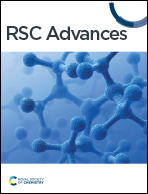Qualifying the contribution of fiber diameter on the acrylate-based electrospun shape memory polymer nano/microfiber properties†
Abstract
Fibrous shape memory polymers (SMPs) have received growing interest in various applications, especially in biomedical applications, which offer new structures at the microscopic level and the potential of enhanced shape deformation of SMPs. In this paper, we report on the development and investigation of the properties of acrylate-based shape memory polymer fibers, fabricated by electrospinning technology with the addition of polystyrene (PS). Fibers with different diameters are manufactured using four different PS solution concentrations (25, 30, 35, and 40 wt%) and three flow rates (1.0, 2.5, and 5.0 μL min−1) with a 25 kV applied voltage and 17 cm electrospinning distance. Scanning electron microscope (SEM) images reveal that the average fiber diameter varies with polymer concentration and flow rates, ranging from 0.655 ± 0.376 to 4.975 ± 1.634 μm. Dynamic mechanical analysis (DMA) and stress–strain testing present that the glass transition temperature and tensile values are affected by fiber diameter distribution. The cyclic bending test directly proves that the electrospun SMP fiber webs are able to fully recover; additionally, the recovery speed is also affected by fiber diameter. With the combination of the SMP material and electrospinning technology, this work paves the way in designing and optimizing future SMP fibers properties by adjusting the fiber diameter.



 Please wait while we load your content...
Please wait while we load your content...